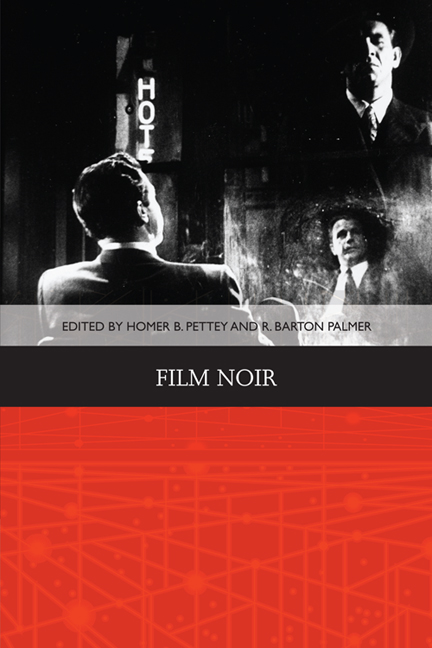Book contents
- Frontmatter
- Contents
- List of Illustrations
- Acknowledgements
- Notes on the Contributors
- Introduction: The Noir Turn
- 1 The Cinema of Uncertainty and the Opacity of Information from Louis Feuillade's Crime Serials to Film Noir
- 2 Warning Shadows: German Expressionism and American Film Noir
- 3 Hard-boiled Tradition and Early Film Noir
- 4 Cold War Noir
- 5 Noiring the Pitch: The Conflicted Soundtracks of Out of the Past, The Blue Gardenia and The Long Goodbye
- 6 Split Screen: Sound/Music in The Stranger/Criss Cross
- 7 Gender and Noir
- 8 The Subversive Shade of Black in Film Noir
- Postscript: A History of Our Writing about Film Noir
- Selected Book Chapters on Film Noir
- Selected Film Noir Books
- Selected Guide to Film Noir
- Index
Postscript: A History of Our Writing about Film Noir
Published online by Cambridge University Press: 05 August 2016
- Frontmatter
- Contents
- List of Illustrations
- Acknowledgements
- Notes on the Contributors
- Introduction: The Noir Turn
- 1 The Cinema of Uncertainty and the Opacity of Information from Louis Feuillade's Crime Serials to Film Noir
- 2 Warning Shadows: German Expressionism and American Film Noir
- 3 Hard-boiled Tradition and Early Film Noir
- 4 Cold War Noir
- 5 Noiring the Pitch: The Conflicted Soundtracks of Out of the Past, The Blue Gardenia and The Long Goodbye
- 6 Split Screen: Sound/Music in The Stranger/Criss Cross
- 7 Gender and Noir
- 8 The Subversive Shade of Black in Film Noir
- Postscript: A History of Our Writing about Film Noir
- Selected Book Chapters on Film Noir
- Selected Film Noir Books
- Selected Guide to Film Noir
- Index
Summary
DEFINING THE SUBJECT
Our involvement in noir criticism goes back to the 1970s. While enrolled in the film school at the University of California, Los Angeles, we collaborated on two books: an auteur study of David Lean and a genre study of the vampire film. In 1974 Alain Silver queried the Indiana University Press and was offered a contract to produce a volume on film noir for the Cinema One Series. When two collaborators dropped out of that project, the offer lost a lot of its lustre. Shortly thereafter, an excerpt from Alain's book-length study of the samurai film appeared in Film Comment. This, in turn, prompted a query from Peter Mayer at The Overlook Press, who was unaware that his book The Samurai Film had been pre-sold to another publisher. Undeterred Peter asked what other subjects we might be considering. When film noir was mentioned, the idea for an encyclopedia was his.
In retrospect, it should have been clear that such an undertaking at a time when very few of the titles of the classic period were available on demand – and then only via rentals of 16mm prints – would have to rely too heavily on the memories of the editors and contributors. When the deal was struck in the Santa Monica living room of Elizabeth Ward, who became the editor in charge of research, no one realised how monumental a task it would be. Before it was finished, the index cards that Elizabeth used to compile filmographic, bibliographic and other details numbered 16,000. The typescript of the book's index alone was over 300 pages long. The main text was almost ten times as many pages, created by diverse hands, few of whom had access to IBM Selectrics, with a melange of Pica and Elite fonts and mostly triple-spaced to permit room for revisions and redactions that were so heavy in places, it was remarkable that a typesetter could decipher them. None of this is to say the time was not right for this endeavour. Aside from Durgnat's ‘family tree’, Schrader's ‘notes’ and a chapter called ‘Black Cinema’ in Higham and Greenberg's Hollywood in the Forties, there was nothing in English attempting to define the film noir movement (or genre, as some have always characterised it).
- Type
- Chapter
- Information
- Film Noir , pp. 182 - 191Publisher: Edinburgh University PressPrint publication year: 2014



